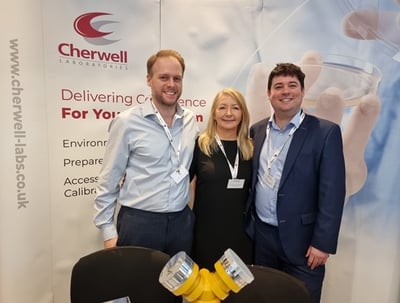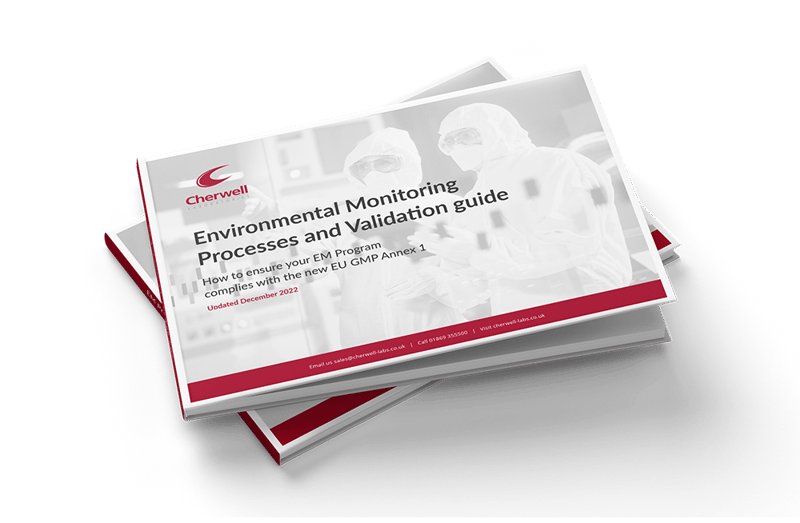After performing virtual and hybrid events for the past 2 years, Pharmig held a face-to-face conference to celebrate its anniversary at the end of November 2022. This non-profit organisation, has been sharing knowledge, and understanding the requirements of microbiology contamination control compliance in the pharmaceutical industry for 30 years.
Cherwell were honoured to attend this milestone event. We exhibited Redipor® prepared media and SAS air samplers . All of which are available as part of an effective environmental monitoring (EM) programme, that spans all graded areas.

The focus of the event was the ongoing challenge of microbiological contamination control compliance from the release of the new Annex 1. The leading presentation was titled 'The new Annex 1... what is in it, what does it mean and what do we need to do?' As presentations continued throughout the day, they discussed ways on how to meet the new Annex 1; the methods available and how the guidance can be interpreted.
To share our extensive knowledge and expertise within our specialist area of EM, Cherwell hosted a discussion on each day, addressing the humble settle plate, and its application in the industry, which is used as a valuable tool to deliver very high value data points. Debating where settle plates are used as part of the EM programme and as a solution for your continuous monitoring, the discussion was titled 'Let's settle the debate'.
The open discussion considered how facilities and individuals interpreted and conducted continuous air monitoring according to the section 9.24 in Annex 1 and we used this key section to drive the open discussion. "9.24 Continuous viable air monitoring in grade A (e.g. air sampling or settle plates) should be undertaken for the full duration of critical processing, including equipment (aseptic set-up) assembly and critical processing."
After a period of time, the debate started to flow, with different perspectives, opinions, and interpretations of the Annex 1 coming to light. For example, some delegates interpreted the guidance to use settle plates all through their facility, as part of continuous monitoring, as it refers to settle plates throughout the Annex 1 document. Others said, because their facility falls into a Grade C category, that settle plates were a perfectly useful tool to be compliant. This raised the question whether they had considered additional methods and if they should be applying them, such as air samplers, to ensure a full understanding of their environment.
Some delegates commented that they had started to use new technologies for viable particulates to understand their environment further, as it is stated in the Annex 1 that new technology can be considered for their environmental monitoring programme. The facilities where the filling line is fully automated with robotics, means that there were no human interventions to increase the risk of contamination. This raises the question; could it be justified that you are managing your risk appropriately if you don't use growth media in this scenario? If there are excursions in this scenario, has the new technology been validated, can the organism be confirmed and identified? Which is a requirement as part of Annex 1.
This is where a possible holistic approach and multiple methods could provide full scope of the cleanroom environment. Utilising some settle plates, or possibly contact plates, within the automated robotic environment alongside the new technology, would provide viable CFU information, if present.
On day 2, we were joined by Gethin Jones - Director of Pinpoint Scientific, who co-chaired the second discussion session, giving his perspective that you need to be performing the best method for what you define as a critical area or process. He cited that the new Annex 1 requires sampling to 1 micron and questioned whether a settle plate or active air sampler can provide this efficiency in these areas.
Overall, from the discussions, there was an acknowledgement that a deeper dive, could present clear EM data. The challenge is to understand the findings and the implications associated with them.
Should the industry strive to improve their environmental monitoring as it informs the facilities contamination control strategy? The risk-assessment and management of a facility and their critical areas, should inform the choices made on the methodology used, as part of the environmental monitoring programme and that it has a holistic approach. If new information becomes available from a newly developed EM programme that incorporates multiple methods, it should be seen that the facility is doing more and working on improving the safety of their product.
Generally, the consensus from the discussion groups was that delegates would continue to use settle plates as part of their EM programmes. We came away from the discussion groups with the understanding that most delegates would continue to use their existing methods (such as settle plates) but would start to evaluate their EM programme in more detail and consider whether additional methods were required.
The perspective throughout Pharmig and from other events around environmental monitoring is, as long as you understand how and why you use your chosen method(s) and can demonstrate and justify this clearly to the regulator as part of your contamination control strategy, this would be considered as compliance. Anyone in the Pharma, ATMPS, and other GMP industries, should have confidence in what they are delivering as part of their EM, as there are multiple solutions for all graded areas and processes therefore, companies should have the ability to push back if necessary, on observations from auditors.
The evening gala is always something to behold, especially after a day of intense discussion and presentations, the delegates now had the chance to let their hair down. David Keen, the Chairman of Pharmig, was an excellent host as always and too many, and I mean too many (as records were broken) baby Guinness' consumed. I will let the reader find out what this is!







